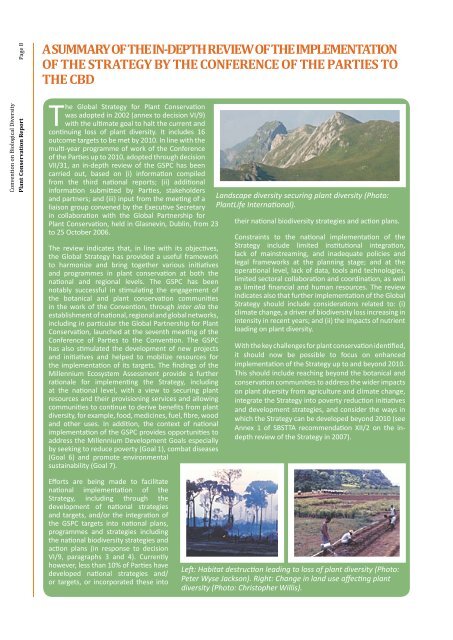from the global partnership for plant conservation
from the global partnership for plant conservation
from the global partnership for plant conservation
You also want an ePaper? Increase the reach of your titles
YUMPU automatically turns print PDFs into web optimized ePapers that Google loves.
Convention on Biological DiversityPlant Conservation Report Page 8A SUMMARY OF THE IN-DEPTH REVIEW OF THE IMPLEMENTATIONOF THE STRATEGY BY THE CONFERENCE OF THE PARTIES TOTHE CBDThe Global Strategy <strong>for</strong> Plant Conservationwas adopted in 2002 (annex to decision VI/9)with <strong>the</strong> ultimate goal to halt <strong>the</strong> current andcontinuing loss of <strong>plant</strong> diversity. It includes 16outcome targets to be met by 2010. In line with <strong>the</strong>multi-year programme of work of <strong>the</strong> Conferenceof <strong>the</strong> Parties up to 2010, adopted through decisionVII/31, an in-depth review of <strong>the</strong> GSPC has beencarried out, based on (i) in<strong>for</strong>mation compiled<strong>from</strong> <strong>the</strong> third national reports; (ii) additionalin<strong>for</strong>mation submitted by Parties, stakeholdersand partners; and (iii) input <strong>from</strong> <strong>the</strong> meeting of aliaison group convened by <strong>the</strong> Executive Secretaryin collaboration with <strong>the</strong> Global Partnership <strong>for</strong>Plant Conservation, held in Glasnevin, Dublin, <strong>from</strong> 23to 25 October 2006.The review indicates that, in line with its objectives,<strong>the</strong> Global Strategy has provided a useful frameworkto harmonize and bring toge<strong>the</strong>r various initiativesand programmes in <strong>plant</strong> <strong>conservation</strong> at both <strong>the</strong>national and regional levels. The GSPC has beennotably successful in stimulating <strong>the</strong> engagement of<strong>the</strong> botanical and <strong>plant</strong> <strong>conservation</strong> communitiesin <strong>the</strong> work of <strong>the</strong> Convention, through inter alia <strong>the</strong>establishment of national, regional and <strong>global</strong> networks,including in particular <strong>the</strong> Global Partnership <strong>for</strong> PlantConservation, launched at <strong>the</strong> seventh meeting of <strong>the</strong>Conference of Parties to <strong>the</strong> Convention. The GSPChas also stimulated <strong>the</strong> development of new projectsand initiatives and helped to mobilize resources <strong>for</strong><strong>the</strong> implementation of its targets. The findings of <strong>the</strong>Millennium Ecosystem Assessment provide a fur<strong>the</strong>rrationale <strong>for</strong> implementing <strong>the</strong> Strategy, includingat <strong>the</strong> national level, with a view to securing <strong>plant</strong>resources and <strong>the</strong>ir provisioning services and allowingcommunities to continue to derive benefits <strong>from</strong> <strong>plant</strong>diversity, <strong>for</strong> example, food, medicines, fuel, fibre, woodand o<strong>the</strong>r uses. In addition, <strong>the</strong> context of nationalimplementation of <strong>the</strong> GSPC provides opportunities toaddress <strong>the</strong> Millennium Development Goals especiallyby seeking to reduce poverty (Goal 1), combat diseases(Goal 6) and promote environmentalsustainability (Goal 7).Landscape diversity securing <strong>plant</strong> diversity (Photo:PlantLife International).<strong>the</strong>ir national biodiversity strategies and action plans.Constraints to <strong>the</strong> national implementation of <strong>the</strong>Strategy include limited institutional integration,lack of mainstreaming, and inadequate policies andlegal frameworks at <strong>the</strong> planning stage; and at <strong>the</strong>operational level, lack of data, tools and technologies,limited sectoral collaboration and coordination, as wellas limited financial and human resources. The reviewindicates also that fur<strong>the</strong>r implementation of <strong>the</strong> GlobalStrategy should include considerations related to: (i)climate change, a driver of biodiversity loss increasing inintensity in recent years; and (ii) <strong>the</strong> impacts of nutrientloading on <strong>plant</strong> diversity.With <strong>the</strong> key challenges <strong>for</strong> <strong>plant</strong> <strong>conservation</strong> identified,it should now be possible to focus on enhancedimplementation of <strong>the</strong> Strategy up to and beyond 2010.This should include reaching beyond <strong>the</strong> botanical and<strong>conservation</strong> communities to address <strong>the</strong> wider impactson <strong>plant</strong> diversity <strong>from</strong> agriculture and climate change,integrate <strong>the</strong> Strategy into poverty reduction initiativesand development strategies, and consider <strong>the</strong> ways inwhich <strong>the</strong> Strategy can be developed beyond 2010 (seeAnnex 1 of SBSTTA recommendation XII/2 on <strong>the</strong> indepthreview of <strong>the</strong> Strategy in 2007).Ef<strong>for</strong>ts are being made to facilitatenational implementation of <strong>the</strong>Strategy, including through <strong>the</strong>development of national strategiesand targets, and/or <strong>the</strong> integration of<strong>the</strong> GSPC targets into national plans,programmes and strategies including<strong>the</strong> national biodiversity strategies andaction plans (in response to decisionVI/9, paragraphs 3 and 4). Currentlyhowever, less than 10% of Parties havedeveloped national strategies and/or targets, or incorporated <strong>the</strong>se intoLeft: Habitat destruction leading to loss of <strong>plant</strong> diversity (Photo:Peter Wyse Jackson). Right: Change in land use affecting <strong>plant</strong>diversity (Photo: Christopher Willis).
















